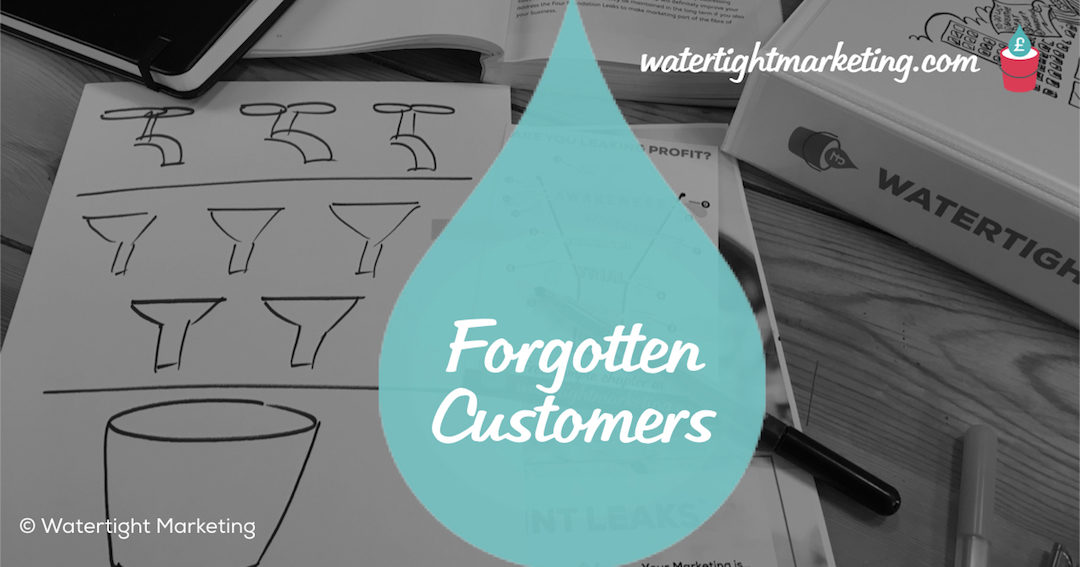Fantastic! You have a new customer. Now what?
Most people will get on with the work, do a great job, finish it on time and on budget and then move on to another project for another customer. Surely the most important thing is to do a good job? So, what am I doing wrong?
1. No reassurance
When they become a customer, make sure you send them something in those early days to reassure them that they’ve made the right decision. It could be, for instance, a welcome letter, giving details of team members and how to contact them, it could be an article relevant to the work you’re doing with them, it could be an invitation to some ‘client only’ event. (Check out Touchpoint Leak #1 ‘Forgotten Customers’ in Watertight Marketing.)
2. Don’t manage expectations
At the outset it’s important to make sure you have discussed with them what their expectations are of your service delivery. I don’t just mean that you’ll reply to emails within 24 hours and phone calls within the day, although these are part of what you might agree with them. It’s also how often they want an update from you (even if there’s nothing much to update), how they like to communicate (phone, email or face to face), how much detail they want from you about the work that you’re doing and what detail, whether they are happy to deal directly with other team members or always want to speak to you, how often they want to be invoiced, whether you need to alert them when they’re reached a certain spend. (Check out Marketing Task = Consistency in Watertight Marketing)
3. Don’t share enough information with team members
To make sure everyone is delivering a great service, you need to bring the team into the fold – let them know about the company, the context of the work you’re doing, why they came to you, what their expectations are (see number 2), how the team will work together, how best to communicate and what should you communicate, what you (as the lead person) would like to know from team members. (Check out Touchpoint Leak #2 ‘Poor On-boarding’ in Watertight Marketing).
4. Forget to check how happy they are
It is worth checking how happy the customer is at various points: a little way into the project to make sure things are going well and to iron out any initial niggles, mid-way to check you’re keeping up the good work and great service, after the work to see how you’ve done. This is all in addition to any regular, e.g. annual, reviews you might do with clients. (Check out Touchpoint Leak #1 ‘Forgotten Customers’ in Watertight Marketing.)
5. Don’t keep in contact after the work is finished
Once you’ve completed the work, you may wonder why, and how, you should keep in touch with your customers. There are numerous reasons why this is a good idea, including: so you remain on the radar in case any other work comes up, you’ve enjoyed working together and want to keep in contact, they may move to another company and it would be good to take your relationship with them, it doesn’t look as though you’re only in contact when you want some more work, you can add value by sending relevant information which might help them in their job. (Check out Touchpoint Leak #1 ‘Forgotten Customers’ in Watertight Marketing.)
6. Send information that’s not relevant
This leads on from number 5 – there’s no point in sending them information or articles which aren’t relevant. This includes that new manager you’ve brought on board and your new offices. The key question to ask of the material you send is: will this person find it interesting, informative, valuable? Of course it can be fun too – if that’s appropriate to the relationship you have. (Check out The Awareness Equation in Watertight Marketing.)
7. Forget to consider your ‘moments of truth’
A wider issue than dealing with you and the team. These “moments of truth” relate to every time a customer comes in contact with your company – reception, voicemail, messages left and knowing they’ll be passed on and calls returned, letters and emails sent out, tone and manner of receptionists or other staff they deal with, the experience they have of your website, even what it’s like to receive an invoice from you. There are usually literally thousands of ways a customer could experience your company. Are they are all up to the standard you want? (Check out Commercial Karma in Watertight Marketing.)
© Rachael Wheatley – Bluegreen Learning. This article originally appeared here.
By Rachael Wheatley – Watertight Marketing Certified Practitioner. Rachael is a strategic marketing consultant with over 20 years of experience, with a focus on integrated marketing and sales for sustainable results. See Rachael’s full profile
Questions? Drop me a line on Twitter: @bluegreenlearn


